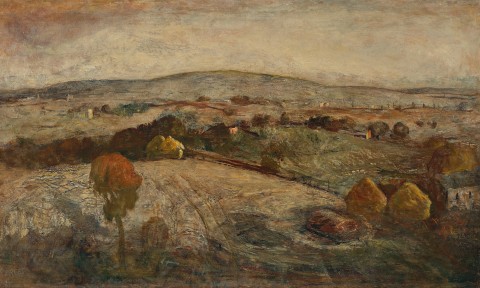HILLS OF BATHURST, c.1944
LLOYD REES
oil on canvas
46.0 x 76.5 cm
signed lower left: L REES
Macquarie Galleries, Sydney (partial label attached verso)
Private collection
Christie’s, London, 4 June 1985, lot 281
Geoff K. Gray, Sydney, 3 March 1986, lot 163
Joseph Brown Gallery, Melbourne
Wesfarmers Art Collection, Perth, acquired from the above in 1986 (label attached verso)
Deutscher and Hackett, Melbourne, 29 August 2012, lot 5
Private collection, Sydney
Society of Artists Annual Exhibition, Education Department Gallery, Sydney, 24 August – 11 September 1946
Joseph Brown Gallery, Melbourne, 1986
The Song of the Lamb: The Wesfarmers Collection of Australian Art, Art Gallery of Western Australia, Perth, 19 August – 2 October 1989
Society of Artists Book 1946–7, Ure Smith Pty Ltd, Sydney, 1947, p. 57 (illus.)
Ure Smith, S. (ed.), Present Day Art in Australia, Ure Smith Pty Ltd, Sydney, 1949, rev. ed, p. 23 (illus.)
Gooding, J., Topliss, H., Sharkey, C., and Horridge, N., The Song of the Lamb: The Wesfarmers Collection of Australian Art, Art Gallery of Western Australia, Perth, 1989, p. 91 (illus.)
We are grateful to Brenda Martin Thomas, wife of the late David Thomas AM, for kindly allowing us to reproduce David’s research and writing in this catalogue entry.
In his mastery of the landscape, Lloyd Rees imbued his paintings with life and atmosphere, overflowing with memories. Through the tilled soils and ancient buildings in his paintings of France, Italy and Greece, Rees celebrated man’s beneficial presence over the millennia. In Australia he brought that same humanising element to his work, of houses, haystacks and other evidence of habitation, as is so evident in Hills of Bathurst, c.1944. The fruitfulness of his views is matched by the fertility of his imagination, rich in romantic associations and bathed in light that is almost palpable. Brett Whiteley, who greatly admired Rees’s art, described his paintings as ‘completely real descriptions, yet abstract at the same time.’1 The formal qualities of his work are as appealing as the recollections they evoke. Landforms swell and whisper of fertility and the goodness of the earth. Of landscape painting, Rees wrote, ‘In the first case the inspiring moment would come from nature; a glimpse of exciting shapes and forms, or a passing mood of light or air. These would be fixed in memory by a sketch... and from this the picture would grow.’2 The painting, of course, ‘has an inner life of its own, independent of the subject matter’ and grew freely in the studio.
The light in Hills of Bathurst evokes the living past – of Australia’s oldest inland settlement, where gold was first discovered, rich in beauty and memories. His first major painting of the area was the evocatively spellbinding Evening on the Bathurst Hills, 1936 in the collection of the Art Gallery of New South Wales, Sydney. It is the soft evening light when nature enticingly attires herself in gentler robe as encroaching shadows tempt and tantalise. Over the following years he painted the Bathurst region at various times and seasons. Evening Landscape, Orange, 1943, also in the Sydney Gallery’s collection, suggests that it was painted from a spot near to the painting on offer.3 Related in time and mood, they share a breadth of sky, easy horizon line, and scattering of houses, all handled in a similar colour scheme. The scene must have appealed greatly to Rees for in 1944 he painted September Landscape, Orange. Betraying even more affinities with our painting, its season of rebirth and renewal is more pronounced through the enveloping golden light.4
Rees created a magical mixture of springtime and evening calm in Hills of Bathurst, a twilight of recollections touched with wistfulness. His Bathurst landscapes stretch from the mid-thirties through to the sixties – often of autumn and spring when nature is at her lyrical best. Certain places had a special appeal for Rees – Bathurst on the Central Tablelands of New South Wales, Gerringong on the south coast’s Illawarra region, and San Gimignano in Tuscany being prominent. He returned to them time and again in his art. Bathurst and its beautiful countryside held particular appeal as his wife Marjory was ‘a Bathurst girl.’
1. Whiteley, B., cited in Artists Salute Lloyd Rees on the occasion of his ninetieth birthday, Macquarie Galleries, Sydney, 1985, p. 7
2. Rees, L., The Small Treasures of a Lifetime, Ure Smith, Sydney, 1969, p. 150
3. Evening Landscape, Orange, 1943, oil on canvas on plywood, 40.0 x 50.5 cm, Art Gallery of New South Wales, Sydney, was a 1943 Wynne Prize finalist.
4. September Landscape, Orange, 1944, oil on canvas, 38.0 x 48.0 cm, in the collection of Mrs John Baillieu of Melbourne, when included in Rees’s 1969 retrospective exhibition at the Art Gallery of New South Wales. The work was also exhibited in Herald Exhibition of Present-Day Australian Art, Melbourne, 1945 and illustrated in Present Day Art in Australia 2, Ure Smith Pty Ltd, Sydney, 1945, p. 70
